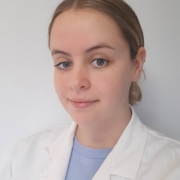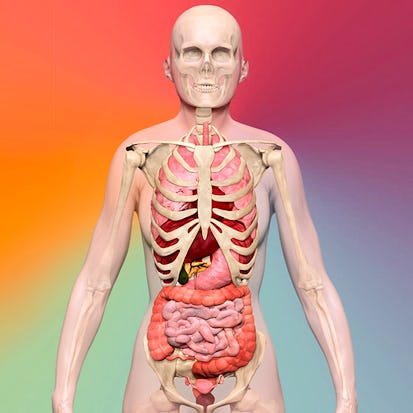- Level Professional
- المدة 22 ساعات hours
- الطبع بواسطة University of Glasgow
-
Offered by

عن
Visualisation is a rapidly progressive specialty in academia, research and industry, and becoming the future of science. With the advancement of digital technologies and their applications, biomedical visualisation is an evolving and popular field. With new techniques and technologies to image, process and analyse data related to the human body, and its biological processes, it is at the forefront of the digital revolution. Why not view our course trailer video. Copy and paste this link into your browser https://youtu.be/vB_QcIVSiTs By the end of this course, you will be able to: Define and describe anatomical terminology related to the human body. Describe the various body systems, what comprises them, and how they relate to function. Create your own 3D modelling and animations using industry standard, open-source software (Blender). Analyse various visualisation techniques and methods, and be able to apply them to areas of biomedical science. This course is the first of its kind on Coursera. It explores the structure and function of the human body including terminology used. It showcases visualisation techniques available using technology to image and display data related to the body and biological processes.. It also provides training in the creation of animations, and examines the applicability of different types of reality. You will learn from experts in these fields and with the knowledge you will gain from this course, be able to evaluate and apply how best to use visualisation in your own discipline. No prior experience is necessary but should be able to learn at an intermediate level.الوحدات
Introduction to Biomedical Visualisation
1
Discussions
- What Does Visualisation Mean to You?
1
Videos
- Week 1 Overview
2
Readings
- Meet the Course Educators
- What We Mean by Visualisation
Introduction to the Human Body
1
Assignment
- Structure and Terminology Formative Assessment
3
Videos
- Human Structure
- Anatomical Terminology
- Muscle Movements
1
Readings
- Terminology Tables
Body Systems and the Musculoskeletal System
1
Assignment
- The Body Systems Formative Assessment
1
Discussions
- Musculoskeletal Visualisation
1
Videos
- Interview from Prof. Niall MacFarlane: Musculoskeletal Applications in Sport Science
2
Readings
- Body Systems
- The Musculoskeletal System
Applications in Biomedical Visualisation
1
Assignment
- End of Week 1 Graded Assessment
1
Discussions
- Using Applications in Your Area of Interest
3
Readings
- Introduction to Applications in Biomedical Visualisation
- Gross Visualisation
- Microscopic Visualisation
Background and Applications of 3D Models and Animation
1
Assignment
- 3D Models and Animations Formative Assessment
1
Discussions
- What would be an example of a successful animation in your specialised field?
1
Videos
- Week 2 Overview
3
Readings
- Introduction to 3D Models and Animation
- Applications of 3D Models and Animations
- Segmentation of Medical Imaging
Blender Basics and Terminology
1
Videos
- Getting Comfortable with Blender
1
Readings
- Blender Keyboard Shortcuts and Terminology
3D Modelling, Textures and Lighting in Blender
1
Assignment
- Formative Assessment: Modelling Terminology
2
Discussions
- Discussion of Modelling in Blender
- Discussion of Materials and Textures in Blender
3
Videos
- Modelling Techniques in Blender
- Modelling Practical in Blender
- Final Touches in Modelling: Modifiers
2
Readings
- Other Resources to Find or Create Models and Textures
- Textures and Lighting
Animation in Blender and End of Week Assessment
1
Assignment
- End of Week Summative Assessment
Overview of the Realities
1
Discussions
- First and Favourtie Virtual Reality Experiences?
1
Videos
- Week 3 Overview
1
Readings
- Definitions: The Realities and Background
Application and Successes of Virtual Reality
2
Assignment
- Formative Assessment: VR Terms and background
- Formative Assessment: Applications of Virtual Reality
1
Discussions
- Where do you expect to see the different realities developing in the future?
2
Videos
- Interview with Dr Neil McDonnell: Immersive Education & Project Mobius
- Interview with Dr Craig Daly: Confocal Microscopy to VR
4
Readings
- Applications of Virtual Reality
- Key Note Lecture by Professor Paul Chapman - Introduction
- Not all Medical: Other Unconventional Applications
- Applications of VR and AR
Drawbacks and Thinking about the Future
1
Discussions
- Fad or Future?
1
Readings
- The Downside of VR
Augmented Reality and Immersion
2
Videos
- Interview with Dr Neil McDonnell Part 2: AR and Its Future
- Interview with Dr Matthieu Poyade
2
Readings
- The Rise of Augmented Reality.
- The Power of Immersion
Summative Quiz
1
Assignment
- Summative Assessment
Mixed Reality and Applications
1
Assignment
- Formative Quiz
2
Videos
- Week 4 Overview
- Interview with Dr Claudia Krebs: The HoloBrain in WebVR
3
Readings
- Mixed Reality: Where It Fits
- Mixed Reality in Minimally Invasive Surgery
- Endoscopic Navigation and Augmented Reality
Extended Reality
2
Readings
- Extended Reality
- Use of Extended Realities in Cardiology
Applications and Challenges of Various Realities
1
Discussions
- Challenges of Realities Discussion
2
Videos
- Podcast with Professor Paul M. Rea
- Interview with Dr Claudia Krebs: Creating a 3D & AR Pelvic Structure
2
Readings
- Podcast with Professor Paul M. Rea - Introduction
- Challenges of Realities
Future Directions for the World of Various Realities
1
Assignment
- Formative Assessment: Various Realities
2
Discussions
- Reflective Exercise Part 1
- Reflective Exercise Part 2
3
Readings
- Where are we now and the future
- Beyond the Field of Science
- The ethical dilemma using technology in healthcare
Summative Quiz
1
Assignment
- End of Week 4 Assessment
Further Information
2
Videos
- Further Study - MSc in Medical Visualisation and Human Anatomy
- Congratulations for completing this Course; final remarks.
1
Readings
- A Special Thanks To...
Auto Summary
Explore the cutting-edge field of Biomedical Visualisation, a rapidly evolving specialty within health and fitness. This Coursera course, led by expert instructors, delves into anatomical terminology, body systems, and advanced visualisation techniques. Learners will gain hands-on experience with 3D modeling and animations using Blender, an industry-standard software. Suitable for intermediate learners, the course spans 1320 minutes and offers two subscription options: Starter and Professional. Perfect for those aiming to integrate digital visualisation into biomedical science. No prior experience required.

Paul Rea

Amy Webster


